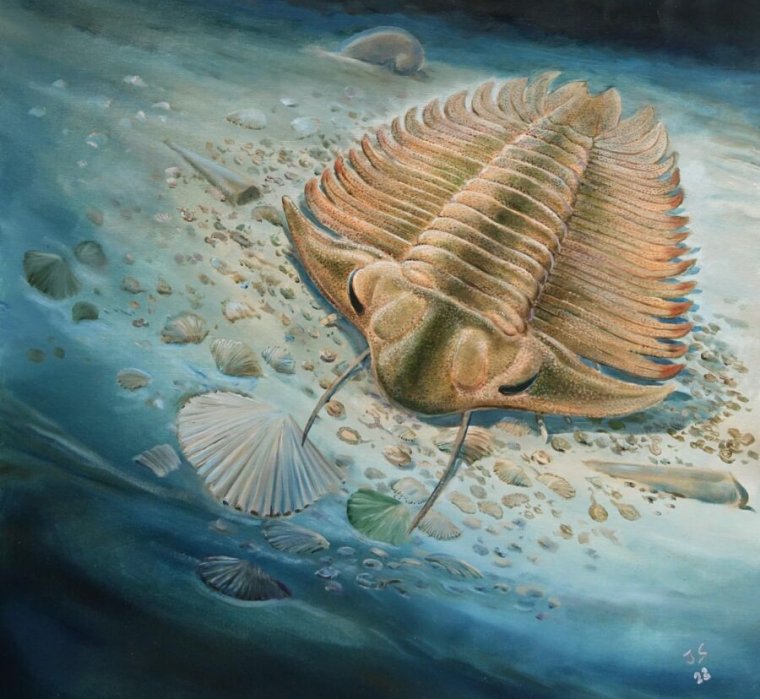
Jiri Svoboda
Trilobites first appear early in the Cambrian and are one of the earliest examples of arthropods, the group that includes all insects. They flourished for over 100 million years, leaving fossils that are seemingly ubiquitous—we’ve described over 20,000 different trilobite species. That’s over three times the number of mammalian species we’re aware of.
Despite all those fossils, however, we’ve never found one with a meal inside it. We’ve been able to infer what some of them were likely to have been dining on based on their appearance and the ecosystems they were found in, but we haven’t been able to establish what they ate with certainty. But today, researchers are describing an exquisitely preserved sample that includes several of the animal’s last meals, which suggests that this particular animal was a bit like an aquatic vacuum cleaner.
The last several suppers
The fossil comes from shale deposits found in the Prague Basin of the Czech Republic. Those rocks date from the Ordovician, which came immediately after the Cambrian and lasted until about 450 million years ago. Mixed in among the layers of shale here are harder silicate nodules that have been termed “Rokycany Balls.” When these nodules contain fossils, they tend to be well-preserved and provide three-dimensional details of the long-dead organisms.
The nodule described by a team of Czech scientists contains a roughly 5-centimeter fossil of a relatively rare trilobite of a previously described species called Bohemolichas incola. In addition to capturing much of its external anatomy in exquisite detail, the researchers were able to image its interior using radiation from a synchrotron, a type of circular particle accelerator.
Running down the center of the animal’s interior was a line of material composed primarily of small pieces of shells. Based on existing arthropods, the researchers conclude that this is almost certainly the remains of its digestive tract. While there are three clusters of material along the track, smaller bits of shell are present between them, providing an outline of the entire digestive tract.
The synchrotron radiation imaging was detailed enough that the species that the trilobite had been eating could be identified. Most of them appeared to be ostracods, a small crustacean that remains common today (there are 13,000 existing ostracod species). Some of these appear to be larval versions of the animal. There are also fragments of thin shells that probably were derived from shellfish like clams and mussels, as well as some pieces of an echinoderm (think starfish and sea urchins).
Overall, the most striking thing about the food present is the sheer variety of it. It appears as if the animal hoovered up anything with a shell it came across on the floor of the body of water it was living in. The key determinant of whether something was food appears to be having a shell weak enough that the trilobite could break through it despite its apparent lack of any ability to crush thick shells. “Food selection was based on size and shell resistance,” the authors write, “rather than [species] composition.” They also say they’re not aware of anything else that seems to have this sort of feeding behavior.
Adapted to feeding?
The researchers speculate that some of the morphology of the animal may involve adaptations to this unusual feeding. The gut itself appears to have a relatively large diameter compared to the size of the organism. There is also material flanking the digestive tube that may represent glands that produced digestive enzymes. The tail end of the animal is also relatively blunt, which may have been needed to allow the passage of the animal’s shell-filled poop. (In case you were curious as to how scientists describe pooping in papers, that’s phrased as something that “may represent a further adaptation, allowing the passage of large undigested particles through the anal opening.”)
One apparent thing is that the shells themselves don’t seem to be digested. This would require an acidic environment and would have liberated lots of calcium, which can pose challenges to animals where muscle contractions are calcium-driven. Instead, the researchers suggest that enzymes digested the soft tissues that started out attached to these shells.
There’s some evidence that this created a noxious environment. A number of burrows suggest that scavengers dug down to reach the trilobite after it was dead and buried. But these burrows appear to have avoided the area around the digestive tract.
The one caution the researchers raise about this find is that the feeding behavior of the trilobite may not be entirely normal. There’s a discontinuity in the animal’s shell between two of its segments, which can be an indication that it’s getting ready to molt. If that’s the case, the animal may have been overeating to generate additional pressure to help it break out of its old shell.
So, after tens of thousands of trilobite fossils, we finally have one with food inside of it. Yet it seems to be from a species that had a bizarre feeding pattern, and this particular individual may have been sucking down more food than usual. So, we’ll probably need to find a few more of these to get a better picture of what trilobites ate.
Nature, 2023. DOI: 10.1038/s41586-023-06567-7 (About DOIs).









